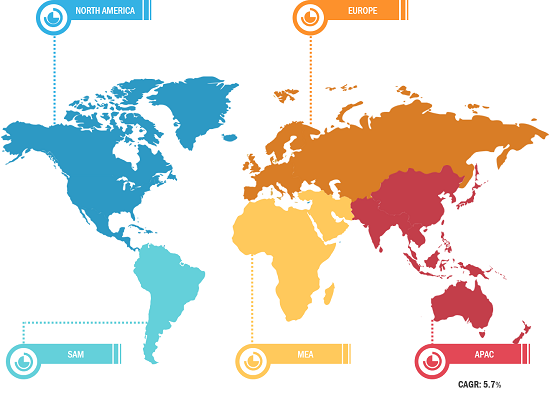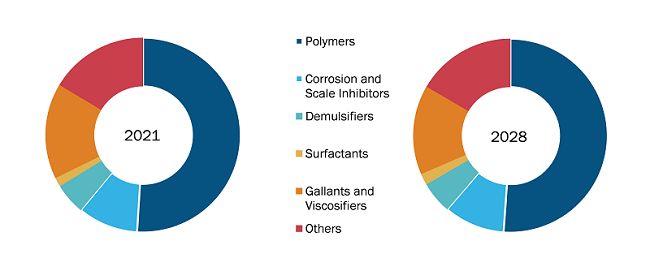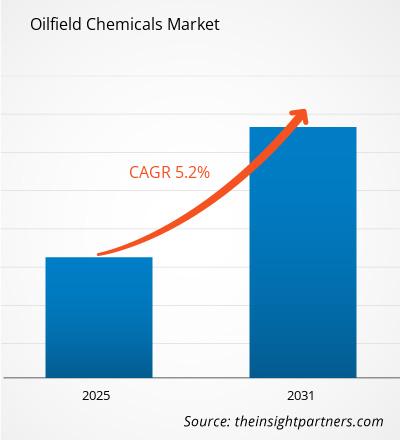Der Markt für Ölfeldchemikalien wird voraussichtlich von 33,05 Milliarden US-Dollar im Jahr 2022 auf 2,5 Milliarden US-Dollar wachsen 47,92 Milliarden Euro bis 2031. Von 2022 bis 2031 wird ein durchschnittliches jährliches Wachstum von 4,8 % erwartet.
Die chemischen Verbindungen, die zur Verbesserung der Effizienz von Abläufen im Zusammenhang mit Ölfeldstandorten für Anwendungen wie Bohren, Produktion, Fertigstellung und andere Vorgänge verwendet werden, werden als Ölfeldchemikalien bezeichnet. Ölfeldchemikalien werden bei Explorations-, Bohr-, Produktions-, Transport- und Destillationsprozessen verwendet. Der Anstieg der Gasbohr-, Tiefsee- und Ultratiefsee-Bohrprojekte dürfte die Nachfrage nach Ölfeldchemikalien ankurbeln. Darüber hinaus sind die steigenden staatlichen Investitionen mehrerer Länder zur Verbesserung der Öl- und Erdölindustrie gestiegen. Es wird erwartet, dass die Gasinfrastruktur den Markt für Ölfeldchemikalien ankurbeln wird.
Die Markt für Ölfeldchemikalien in Nordamerika ist in die USA, Kanada und unterteilt Mexiko. Laut dem Bericht des Council on Foreign Relations sind die USA der weltweit größte Öl- und Gasproduzent. Darüber hinaus ist die beliebte „Schieferrevolution“ steigerte die Öl- und Gasproduktion in den USA. Die Einführung neuer Technologien hat zur Förderung der Offshore-Öl- und Gasförderung geführt. Laut dem 2021 veröffentlichten Bericht der US Energy Information Administration (EIA) findet ein Großteil der Offshore-Bohrungen in den USA im Golf von Mexiko statt. Die USA sind eine Drehscheibe für einige große Öl- und Gasmarktteilnehmer wie Chevron Corporation, ExxonMobil Corporation, ConocoPhillips Company und Occidental Petroleum Corporation. Laut dem Bericht des Environmental and Energy Study Institute (EESI) gewährt die US-Regierung direkte und indirekte Subventionen für die Öl- und Gasindustrie. Gasindustrie. Die direkten Subventionen umfassen den Abzug immaterieller Bohrkosten, der es Unternehmen ermöglicht, einen erheblichen Teil der Kosten abzuziehen, die durch die Bohrung neuer Bohrlöcher im Inland entstehen. Darüber hinaus wird laut der Canadian Association of Petroleum Producers (CAPP) erwartet, dass die weltweite Ölnachfrage bis 2030 um 5 % steigen wird, während die Nachfrage nach Erdgas bis 2030 voraussichtlich um 15 % steigen wird. Daher sind die oben genannten Faktoren verantwortlich für die Beschleunigung des Öls & Gasindustrie in Nordamerika. Das Wachstum des Öls & Die Gasindustrie und die damit verbundenen Betriebe werden voraussichtlich den Markt für Ölfeldchemikalien in der Region ankurbeln.
Strategische Einblicke
Lukrative regionale Märkte für Ölfeldchemikalien
Markteinblicke
Wachsend Nachfrage nach erdölbasierten Kraftstoffen aus der Transportindustrie soll den Markt für Ölfeldchemikalien vorantreiben
Laut dem Bericht der Internationalen Energieagentur wird der weltweite Ölverbrauch bis 2031 voraussichtlich 104,1 Millionen Barrel/Tag erreichen, was einem Anstieg von 4,4 Millionen Barrel/Tag gegenüber dem weltweiten Ölverbrauchstrend von 2021 entspricht. Es wird erwartet, dass der Anstieg der Ölbohr-, Produktions- und Explorationsaktivitäten im Prognosezeitraum zunehmen wird. Im Jahr 2021 enthüllte ein Bericht der India Brand Equity Foundation, dass die Oil and Natural Gas Corporation (ONGC) angeblich 2,73 Milliarden US-Dollar in Erdölbetriebe wie das Bohren von Öl- und Gasquellen investiert hat. Darüber hinaus wird erwartet, dass ausländische Investoren die Möglichkeit haben, sich an Erdöl- und Erdgasprojekten zu beteiligen. Bis 2022 wurde der Projektwert in Indien aufgrund der zunehmenden Unabhängigkeit vom Öl auf 300 Milliarden US-Dollar geschätzt, was zu einem Rückgang der Importe um 10 % führte. Darüber hinaus wird erwartet, dass der Anstieg der Nachfrage nach petrochemischen Produkten im Prognosezeitraum zur steigenden Nachfrage nach Öl beitragen wird. Daher bauen viele Öl produzierende Länder eine petrochemische Infrastruktur auf, um der steigenden Nachfrage gerecht zu werden. Daher wird erwartet, dass die Nachfrage nach Ölfeldchemikalien mit den zunehmenden Öl- und Gasexplorationsprojekten im Prognosezeitraum zunehmen wird.
Produkttypbasierte Einblicke
Je nach Typ ist der Markt für Ölfeldchemikalien in Polymere, Korrosions- und Ablagerungsinhibitoren, Demulgatoren, Tenside, Gallantien und Viskosifizierungsmittel und andere unterteilt. Im Jahr 2021 hielt das Polymersegment den größten Marktanteil.
Marktanteil von Ölfeldchemikalien, nach Typ, 2021 vs. 2031
SMC Oilfield Chemicals, Clariant AG, Solvay SA, Kraton Corporation, BASF SE, Albemarle Corporation, DowDuPont Inc., Kemira Oyj, Chevron Phillips Chemical Company LLC und Nouryon Chemicals Holding BV gehören zu den Hauptakteuren auf dem Markt für Ölfeldchemikalien. Die führenden Akteure verfolgen Strategien wie Fusionen und Fusionen. Akquisitionen und Produkteinführungen, um ihre geografische Präsenz und ihren Kundenkreis zu erweitern.
Berichts-Spotlights
- Progressive Trends in der Ölfeldchemieindustrie, um Spielern bei der Entwicklung effektiver langfristiger Strategien zu helfen
- Geschäftswachstumsstrategien von Unternehmen zur Sicherung des Wachstums in Entwickelte und sich entwickelnde Märkte
- Quantitative Analyse des Marktes für Ölfeldchemikalien von 2021 bis 2031
- Schätzung des Bedarfs an Ölfeldchemikalien
- Porters Fünf-Kräfte-Analyse zur Veranschaulichung der Wirksamkeit von Käufern und Lieferanten, die in der Branche tätig sind
- Neueste Entwicklungen zum Verständnis des Wettbewerbsmarktszenarios
- Markttrends und -aussichten sowie Faktoren, die das Wachstum des Marktes für Ölfeldchemikalien vorantreiben und bremsen
- Strategien verstehen, die kommerzielle Interessen im Hinblick auf das globale Marktwachstum untermauern und den Entscheidungsprozess unterstützen
- Marktgröße für Ölfeldchemikalien an verschiedenen Marktknoten
- Detaillierter Überblick und Segmentierung des Marktes für Ölfeldchemikalien und seiner Branchendynamik
- Marktgröße für Ölfeldchemikalien in verschiedenen Regionen mit vielversprechenden Wachstumschancen
Die „Globale Marktanalyse für Ölfeldchemikalien bis 2031“ ist eine spezialisierte und eingehende Studie der Chemie- und Materialindustrie mit Schwerpunkt auf der Trendanalyse des Marktes für Ölfeldchemikalien. Der Bericht soll einen Überblick darüber geben Der Markt mit detaillierter Marktsegmentierung. Der globale Markt ist nach Typ und Anwendung segmentiert. Basierend auf dem Typ ist der Markt in Polymere, Korrosions- und Ablagerungsinhibitoren, Demulgatoren, Tenside, Gallier- und Viskosifizierungsmittel und andere unterteilt. Je nach Anwendung ist der Markt in Bohren, Zementieren, verbesserte Ölgewinnung, Produktionschemikalien, Bohrlochstimulation sowie Aufarbeitung und Fertigstellung unterteilt.
Firmenprofile
- SMC Oilfield Chemicals
- Clariant AG
- Solvay SA
- Kraton Corporation
- BASF SE
- Albemarle Corporation
- DowDuPont Inc.
- Kemira Oyj
- Chevron Phillips Chemical Company LLC.
- Nouryon Chemicals Holding BV
- Historische Analyse (2 Jahre), Basisjahr, Prognose (7 Jahre) mit CAGR
- PEST- und SWOT-Analyse
- Marktgröße Wert/Volumen – Global, Regional, Land
- Branche und Wettbewerbsumfeld
- Excel-Datensatz


- Small Molecule Drug Discovery Market
- Rugged Servers Market
- Drain Cleaning Equipment Market
- Enteral Nutrition Market
- Fertilizer Additives Market
- Battery Testing Equipment Market
- UV Curing System Market
- Real-Time Location Systems Market
- Bioremediation Technology and Services Market
- Wind Turbine Composites Market

Report Coverage
Revenue forecast, Company Analysis, Industry landscape, Growth factors, and Trends

Segment Covered
This text is related
to segments covered.

Regional Scope
North America, Europe, Asia Pacific, Middle East & Africa, South & Central America

Country Scope
This text is related
to country scope.
Häufig gestellte Fragen
Based on geography, Asia Pacific is expected to register the fastest CAGR from 2023 to 2031.
Growth in shale gas exploration is one of the key opportunities for the market growth.
Albermarle Corporation, BASF SE, Chevron Phillips Chemical Company LLC, Clariant AG, DowDupont Inc, Halliburton Energy Services Inc, Kemira Oyj, Kraton Corporation, Nouryon Chemicals Holding BV, and Solvay SA are among the leading players operating in the oilfield chemicals market.
The report can be delivered in PDF/Word format, we can also share excel data sheet based on request.
Increased exploration and production activities is driving the market growth
The Oilfield Chemicals Market is estimated to witness a CAGR of 5.2% from 2023 to 2031
The List of Companies
- Akzo Nobel N.V.
- Albemarle Corporation
- Baker Hughes
- BASF SE
- Ecolab
- Halliburton
- Newpark Resources Inc.
- Schlumberger Ltd
- Solvay
- The Lubrizol Corporation
The Insight Partners performs research in 4 major stages: Data Collection & Secondary Research, Primary Research, Data Analysis and Data Triangulation & Final Review.
- Data Collection and Secondary Research:
As a market research and consulting firm operating from a decade, we have published and advised several client across the globe. First step for any study will start with an assessment of currently available data and insights from existing reports. Further, historical and current market information is collected from Investor Presentations, Annual Reports, SEC Filings, etc., and other information related to company’s performance and market positioning are gathered from Paid Databases (Factiva, Hoovers, and Reuters) and various other publications available in public domain.
Several associations trade associates, technical forums, institutes, societies and organization are accessed to gain technical as well as market related insights through their publications such as research papers, blogs and press releases related to the studies are referred to get cues about the market. Further, white papers, journals, magazines, and other news articles published in last 3 years are scrutinized and analyzed to understand the current market trends.
- Primary Research:
The primarily interview analysis comprise of data obtained from industry participants interview and answers to survey questions gathered by in-house primary team.
For primary research, interviews are conducted with industry experts/CEOs/Marketing Managers/VPs/Subject Matter Experts from both demand and supply side to get a 360-degree view of the market. The primary team conducts several interviews based on the complexity of the markets to understand the various market trends and dynamics which makes research more credible and precise.
A typical research interview fulfils the following functions:
- Provides first-hand information on the market size, market trends, growth trends, competitive landscape, and outlook
- Validates and strengthens in-house secondary research findings
- Develops the analysis team’s expertise and market understanding
Primary research involves email interactions and telephone interviews for each market, category, segment, and sub-segment across geographies. The participants who typically take part in such a process include, but are not limited to:
- Industry participants: VPs, business development managers, market intelligence managers and national sales managers
- Outside experts: Valuation experts, research analysts and key opinion leaders specializing in the electronics and semiconductor industry.
Below is the breakup of our primary respondents by company, designation, and region:

Once we receive the confirmation from primary research sources or primary respondents, we finalize the base year market estimation and forecast the data as per the macroeconomic and microeconomic factors assessed during data collection.
- Data Analysis:
Once data is validated through both secondary as well as primary respondents, we finalize the market estimations by hypothesis formulation and factor analysis at regional and country level.
- Macro-Economic Factor Analysis:
We analyse macroeconomic indicators such the gross domestic product (GDP), increase in the demand for goods and services across industries, technological advancement, regional economic growth, governmental policies, the influence of COVID-19, PEST analysis, and other aspects. This analysis aids in setting benchmarks for various nations/regions and approximating market splits. Additionally, the general trend of the aforementioned components aid in determining the market's development possibilities.
- Country Level Data:
Various factors that are especially aligned to the country are taken into account to determine the market size for a certain area and country, including the presence of vendors, such as headquarters and offices, the country's GDP, demand patterns, and industry growth. To comprehend the market dynamics for the nation, a number of growth variables, inhibitors, application areas, and current market trends are researched. The aforementioned elements aid in determining the country's overall market's growth potential.
- Company Profile:
The “Table of Contents” is formulated by listing and analyzing more than 25 - 30 companies operating in the market ecosystem across geographies. However, we profile only 10 companies as a standard practice in our syndicate reports. These 10 companies comprise leading, emerging, and regional players. Nonetheless, our analysis is not restricted to the 10 listed companies, we also analyze other companies present in the market to develop a holistic view and understand the prevailing trends. The “Company Profiles” section in the report covers key facts, business description, products & services, financial information, SWOT analysis, and key developments. The financial information presented is extracted from the annual reports and official documents of the publicly listed companies. Upon collecting the information for the sections of respective companies, we verify them via various primary sources and then compile the data in respective company profiles. The company level information helps us in deriving the base number as well as in forecasting the market size.
- Developing Base Number:
Aggregation of sales statistics (2020-2022) and macro-economic factor, and other secondary and primary research insights are utilized to arrive at base number and related market shares for 2022. The data gaps are identified in this step and relevant market data is analyzed, collected from paid primary interviews or databases. On finalizing the base year market size, forecasts are developed on the basis of macro-economic, industry and market growth factors and company level analysis.
- Data Triangulation and Final Review:
The market findings and base year market size calculations are validated from supply as well as demand side. Demand side validations are based on macro-economic factor analysis and benchmarks for respective regions and countries. In case of supply side validations, revenues of major companies are estimated (in case not available) based on industry benchmark, approximate number of employees, product portfolio, and primary interviews revenues are gathered. Further revenue from target product/service segment is assessed to avoid overshooting of market statistics. In case of heavy deviations between supply and demand side values, all thes steps are repeated to achieve synchronization.
We follow an iterative model, wherein we share our research findings with Subject Matter Experts (SME’s) and Key Opinion Leaders (KOLs) until consensus view of the market is not formulated – this model negates any drastic deviation in the opinions of experts. Only validated and universally acceptable research findings are quoted in our reports.
We have important check points that we use to validate our research findings – which we call – data triangulation, where we validate the information, we generate from secondary sources with primary interviews and then we re-validate with our internal data bases and Subject matter experts. This comprehensive model enables us to deliver high quality, reliable data in shortest possible time.

 Holen Sie sich ein kostenloses Muster für diesen Bericht
Holen Sie sich ein kostenloses Muster für diesen Bericht